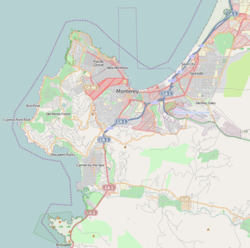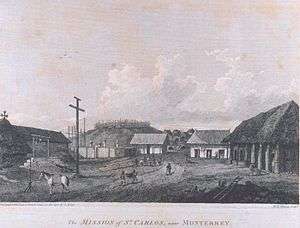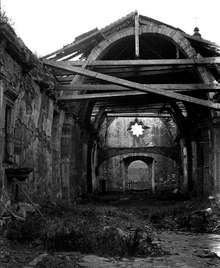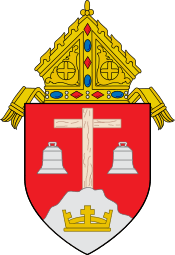Mission San Carlos Borromeo de Carmelo
 The façade of the capilla (chapel) at Mission San Carlos Borromeo de Carmelo. | |
 Location in the Monterey Peninsula | |
| Location | 3080 Rio Rd.Carmel-by-the-Sea, California, 93923 |
|---|---|
| Coordinates | 36°32′34″N 121°55′7″W / 36.54278°N 121.91861°WCoordinates: 36°32′34″N 121°55′7″W / 36.54278°N 121.91861°W |
| Name as founded | La Misión San Carlos Borromeo del Río Carmelo [1] |
| English translation | The Mission of Saint Charles Borromeo of the Carmel River |
| Patron | Saint Charles Borromeo [2] |
| Nickname(s) | "Father of the Alta California Missions" [3] |
| Founding date | June 3, 1770 [4] |
| Founding priest(s) | Father Presidente Junípero Serra[5] |
| Founding Order | Second [2] |
| Headquarters of the Alta California Mission System |
1771–1815; 1819–1824; 1827–1830 [6] |
| Military district | Third [7] |
| Native tribe(s) Spanish name(s) |
Esselen, Ohlone Costeño |
| Native place name(s) | Ekheya [8] |
| Baptisms | 3,827 [9] |
| Marriages | 1,032 [9] |
| Burials | 2,837 [9] |
| Secularized | 1834 [2] |
| Returned to the Church | 1859 [2] |
| Governing body | Roman Catholic Diocese of Monterey |
| Current use | Parish Church/Minor Basilica |
| Official name: Carmel Mission | |
| Designated | October 15, 1966[10] |
| Reference no. | 66000214[10] |
| Designated | October 9, 1960[11] |
| Reference no. |
|
| Website | |
| http://carmelmission.org | |
Mission San Carlos Borromeo del río Carmelo or Misión de San Carlos Borromeo de Carmelo, also known as the Carmel Mission or Mission Carmel, first built in 1797, is one of the most authentically restored Roman Catholic mission churchs in California. Located in Carmel-by-the-Sea, California, it is on the National Register of Historic Places and is a National Historic Landmark. The mission was the headquarters of all Alta California missions from 1797 until 1833. It was headed by Saint Junípero Serra from 1770 until his death in 1784. It was also the seat of the second presidente, Father Fermin Francisco de Lasuen, who was in charge of completing nine more mission churches.
The mission buildings and lands were secularized by the Mexican government in 1833. They fell into disrepair by the mid-19th century. The chapel was saved from total destruction when the roof was rebuilt in 1884.[13][14] In 1886, ownership of the mission was transferred from a group of Franciscans to the Diocese of Monterey. The mission has been a parish within that diocese ever since. Beginning in 1931, Harry Downie began restoring the mission and worked continuously on the project for the next 50 years. It is the only Spanish mission in California that has its original bell and bell tower.[15]
History

)_-_Google_Art_Project.jpg)

Mission Carmel was the second mission built by Franciscan missionaries in Upper California. It was first established as Mission San Carlos Borromeo in Monterey, California near the native village of Tamo on June 3, 1770. It was named for Carlo Borromeo, Archbishop of Milan, Italy, and was the site of the first Christian confirmation in Alta California.[5] When the mission moved, the original building continued to operate as the Royal Presidio chapel and later became the current Cathedral of San Carlos Borromeo.
Relocation to Carmel
Pedro Fages, who served as military governor of Alta California from 1770 to 1774, kept his headquarters in the polity's capitol, at the Presidio of Monterey. Fages worked his men very harshly and was seen as a tyrant. Serra intervened on behalf of Fages' soldiers, and the two men did not get along.[16][17] Fages regarded the Spanish installations in California as military institutions first, and religious outposts second. The soldiers raped the Indian woman and kept them as concubines.[16] Serra wanted to put some distance between the missions neophytes and Fages' soldiers.
Serra found that the land near the mouth of the Carmel River (named Río del Carmelo by Vizcaíno in 1603[18]) was better suited for farming.[19] In May 1771, Spain's viceroy approved Serra's petition to relocate the mission. The mission was established in the new location on August 1, 1771; the first mass was celebrated on August 24, and Serra officially took up residence in the newly constructed buildings on December 24.[20]
The name of the relocated mission was extended to Mission San Carlos Borromeo del Río Carmelo. It was within a short distance of the Rumsen Ohlone villages of Tucutnut and Achasta. The latter village may have been founded after Mission San Carlos was relocated to Carmel. The mission was about 10 miles (16 km) from the nearest Esselen territory, Excelen.[21]
Indian baptisms
After the Carmel mission was moved to Carmel Valley, the Franciscans began to baptize some natives.[22] By the end of 1771, the population of mission was 15 with an additional 22 baptized Indians, out of a total population of northern California of 60.[19]
Farming was not very productive and for several years the mission was dependent upon the arrival of supply ships.[19] Historian Jame Culleton wrote in 1950, "The summer of '73 came without bringing the supply ship. Neither Carmel nor Monterey was anything like self-supporting."[19]
To improve baptismal rates, they sought to convert key members of the Esselen and Rumsen tribes, including chiefs. On May 9, 1775, Junípero Serra baptized what appears to be the first Esselen, Pach-hepas, who was the 40-year-old chief of the Excelen. His baptism took place at Xasáuan, 10 leagues (about 26 miles (42 km)) southeast of the mission, in an area now named Cachagua, a close approximation of the Esselen name.[21] This persuaded some Indians to follow them to the mission.
Forced labor
The Esselen and Ohlone Indians who lived near the mission were baptized and then forcibly relocated and conscripted as forced laborers. Neophytes were taught to be farmers, shepherds, cowboys, blacksmiths, carpenters, bricklayers, furniture makers, tanners, weavers and candle makers. Disease, starvation, overwork, and torture decimated these tribes.[23][24]:114 In 1794, the population reached its peak of 927, but by 1823 the total had dwindled to 381. There was extensive "comingling of the Costanoan with peoples of different linguistic and cultural background during the mission period."[22]
Crops and livestock
In the beginning, the mission relied on bear meat from Mission San Antonio de Padua and supplies brought by ship from Mission San Diego de Alcalá.[19]
In 1779, the natives Americans at Carmel Mission harvested 1660 bushels of wheat, 700 bushels of barley, 165 bushels of beans, and 85 bushels of maize. Four years later, the native laborers produced enough crops to support 700 people. The mission had more than 500 cattle and sheep.[23]
Carmel mission continued to grow during most of the 18th century. The largest population was neophytes was 876 in 1795. By 1800, agriculture production at Carmel Mission was near its peak. The Mission reported to Mexico that it had 2180 horses and cattle, and 4160 smaller livestock including sheep. The total grain harvested was about 3700 bushels per year with a high of 7400 in 1797.[23]
In December 1832, the mission reported to Mexico that it had 2,100 cattle, 3,300 sheep, 410 horses, and 8 mules.[25]
Serra's headquarters
"Mission Carmel", as it came to be known, was Serra's favorite[26] and, because it was close to Monterey, the capital of Alta California, he chose it as his headquarters. When he died on August 28, 1784, he was interred beneath the chapel floor. After Serra's death, Father Fermin Lasuén replaced the adobe structure with one made of stone quarried from the nearby Santa Lucia Mountains.[27]
Secularized and abandoned
Eight months later, in August 1833, the newly independent Mexican government secularized the mission and all its lands. It stipulated that half the mission lands should be awarded to the native people, but this purpose was never accomplished. Most mission property was bought by government officials or their wealthy friends.[23] The priests could not maintain the missions without the Indians' forced labor and the mission and lands were soon abandoned. The Indians were forced from the mission. Some attempted to return to their native ways, and others found work as ranch hands or servants on farms and ranches.[27]
By 1850, the mission was nearly a ruin. The stone chapel building was deteriorating while most of the adobe buildings were eroding away. The roof collapsed in 1852. The U.S. federal government returned the mission and its lands to the Catholic Church in 1859.[25]
Restoration

When Mexico ceded California to the United States following the Mexican–American War, the 1848 Treaty of Guadalupe Hidalgo provided that the land grants would be honored, but required that the owners provide legal proof of their title. As required by the Land Act of 1851, Archbishop Joseph Sadoc Alemany filed a claim on February 19, 1853 on behalf of the Roman Catholic Church. He sought return of all former mission lands in the State. The state agreed to return the original mission buildings, cemeteries, and gardens to the church.[28]:31-32
When the Roman Catholic Church gained full control of the buildings on October 19, 1859, the mission was in ruins.[27] In 1884 Father Angel Casanova was able to gather enough private funds to replace the roof on the chapel sufficient to preserve it until the 1930s. In 1931 Monsignor Philip Scher hired master cabinet maker Henry John ("Harry") Downie who had a excellent reputation for restoring Spanish antiques. Scher initially asked Downie to restore some statues at the Carmel Mission but his job quickly expanded and he was put in charge of restoring the entire mission.[29][25] Two years later, the church transferred the mission from the Franciscans to the local diocese and it became a regular parish church. Downie lived nearby in Carmel and worked almost daily for almost 50 years to restore the mission, ancillary buildings, walls, and grounds. He painstakingly researched the church's architecture and site, often relying on original Spanish sources, and gathered genuine artifacts from across California.[27]
He first restored the padres' quarters, then the roof of the chapel in 1936, and over the next five years the interior of the basilica.[27][30] In 1941, he oversaw restoration of the former soldiers' quarters on the east side of the quadrangle. In 1943 he began restoration of a building that had been on the south side of the quadrangle, although nothing was left but the eroded adobe foundation and a few ruined walls. The building was originally a segregated, locked dormitory for girls called the monjero (nunnery). They were separated from their families at age 8. The boys and unmarried men also had their own dormitory, though it was less confining.[31]:117–119
The building was reconstructed and made into classrooms for Junipero Serra Elementary School. In 1946, the ruin on the east side of the quadrangle that had been the original padre’s kitchen and a blacksmith shop was rebuilt. It is used today as a chapel. Downie also consulted on the restoration of the missions that are considered the most authentic, including San Luis Obispo, San Juan Bautista, and San Buenaventura. He also helped the Native Daughters of the Golden West to reconstruct Mission Soledad.[29] He was knighted by Pope Pius and by King Juan Carlos of Spain.[32][27]
In 1960, the mission was designated as a minor basilica by Pope John XXIII. In 1987, Pope John Paul II visited the mission as part of his U.S. tour.[33][34]
The original bell nicknamed Ave Maria was made in Mexico City in 1807. It was placed at the Mission in 1820. When the mission was secularized in 1834, the bell was removed and held onto by local Native Americans for safekeeping. It was finally lost and relocated once again during restoration. It was re-installed in the mission bell tower in 1925.[15][35]
Modern use
_-_basilica_interior%2C_nave.jpg)
As a result of Downie's dedicated efforts to restore the buildings, the Carmel mission church is one of the most authentically restored of all the mission churches in California. Mission Carmel has been designated a National Historic Landmark by the National Park Service. It is an active parish church of the Roman Catholic Diocese of Monterey.[36][37]
In addition to its activity as a place of worship, Mission Carmel also hosts concerts, art exhibits, lectures and numerous other community events. In 1986, then-pastor Monsignor Eamon MacMahon acquired a Casavant Frères organ with horizontal trumpets. Its hand-painted casework is decorated with elaborate carvings and statuary reflecting the Spanish decorative style seen on the main altar.
The mission also serves as a museum, preserving its own history and the history of the area. There are four specific museum galleries: the Harry Downie Museum, describing restoration efforts; the Munras Family Heritage Museum, describing the history of one of the most important area families; the Jo Mora Chapel Gallery, hosting rotating art exhibits as well as the monumental bronze and travertine cenotaph (1924) sculpted by Jo Mora;[38] and the Convento Museum, which holds the cell Serra lived and died in, as well as interpretive exhibits. At one end of the museum is a special chapel room containing some of the vestments used by Serra.[39][40][41]
The mission grounds are also the location of the Junipero Serra School, a private Catholic school for kindergartners through 8th grade.[42]
Modern restoration
In 2012, the Carmel Mission Foundation began a project to restore the roof of the basilica installed during a restoration in 1937. The project was the third major reconstruction of the basilica since it was built in 1797. The contractor installed additional wood and steel beams to reinforce and tie the roof structure together. To strengthen the walls, they drilled over 300 center-cored vertical and horizontal holes in the 5 feet (1.5 m) thick walls, into which they inserted steel rods that were grouted in place. The project also updated the electrical system and added a fire suppression system. The interior lighting was replaced and custom-made chandeliers were added. The project upgraded the radiant heating system and included construction of an Americans with Disabilities Act-compliant restroom. The project was funded by the Carmel Mission Foundation, which raised about $6.2 million.[37]
In 2016, the foundation funded reconstruction of the Quadrangle Courtyard at a cost of $2.0 million. The uneven, cracked concrete surface was a hazard. It was removed and new water and fire lines, drains, sewer, electrical, and communications lines were installed before a new concrete, durable concrete surface was poured.[37]
The foundation is planning a larger $20 million dollar project in time for the 250th anniversary of the basilica in 2020. It includes seismic retrofits, infrastructure improvements, and restoration of the several historic structures, including the Downie Museum and Orientation Center, Mora Chapel Museum, Convento Museum (including the museum store), and Blessed Sacrament Chapel.[37]
Vandalism
On September 27, 2015, in response to Serra's canonization, the San Carlos Borromeo de Carmelo Mission was vandalized. The statue of Serra was toppled and splattered with paint, and the cemetery, the mission doors, a fountain, and a crucifix were as well. The message "Saint of Genocide" was put on Serra's tomb, and similar messages were painted elsewhere in the mission courtyard.[43][44]
Notable interments
_-_basilica%2C_interior%2C_grave_of_Junipero_Serra.jpg)
Several notable people are buried in the church and churchyard.
- Juan Crespí (1721–1782), Spanish missionary and explorer
- Fermín Lasuén (1736–1803), Spanish missionary and explorer
- José Antonio Roméu, (1742? – 1792) Spanish governor of California
- Junípero Serra (1713–1784), founder of the Spanish missions in California and Saint
See also
- Spanish missions in California
- Cathedral of San Carlos Borroméo (aka Royal Presidio Chapel), Monterey, California
- USNS Mission Carmel (AO-113), a Buenaventura Class fleet oiler built during World War II.
- USNS Mission San Carlos (AO-120), a Buenaventura Class fleet oiler built during World War II.
Notes
References
- ↑ Leffingwell, p. 113
- 1 2 3 4 Krell, p. 83
- ↑ Ruscin, p. 25
- ↑ Yenne, p. 33
- 1 2 Ruscin, p. 196
- ↑ Yenne, p. 186
- ↑ Forbes, p. 202
- ↑ Ruscin, p. 195
- 1 2 3 Krell, p. 315: as of December 31, 1832; information adapted from Engelhardt's Missions and Missionaries of California.
- 1 2 National Park Service (2010-07-09). "National Register Information System". National Register of Historic Places. National Park Service.
- ↑ NHL Summary Archived 2008-06-21 at the Wayback Machine.
- ↑ "Mission San Carlos Borromeo de Carmelo". Office of Historic Preservation, California State Parks. Retrieved 2012-11-23.
- ↑ Dillon, James (September 4, 1976). "Mission San Carlos De Borromeo Del Rio Carmelo" (pdf). National Register of Historic Places – Inventory Nomination Form. National Park Service. Retrieved 22 May 2012.
- ↑ "Mission San Carlos De Borromeo Del Rio Carmelo" (pdf). Photographs. National Park Service. Retrieved 22 May 2012.
- 1 2 "News from California Missions Foundation". archive.constantcontact.com. Retrieved 15 May 2018.
- 1 2 Walton, John (2003). Storied Land: Community and Memory in Monterey. Berkeley, Calif.: University of California Press. p. 15ff. ISBN 9780520935679. Retrieved 5 September 2016.
- ↑ Paddison, p. 23
- ↑ Clark, Donald Thomas. 1991. Monterey County Place Names: a Geographical Dictionary. Carmel Valley, Calif: Kestrel Press.
- 1 2 3 4 5 Breschini, Ph.D., Gary S. (2000). "Mission San Carlos Borromeo (Carmel)". Monterey County Historical Museum. Retrieved 22 June 2013.
- ↑ Smith, p. 18
- 1 2 Breschini, Gary S.; Trudy Haversat. "A Brief Overview of the Esselen Indians of Monterey County". Monterey County Historical Society. Retrieved November 3, 2011.
- 1 2 "Native Americans of San Carlos Borromeo de Carmelo". California Missions Resource Center. Retrieved 30 October 2015.
- 1 2 3 4 "How it all Started". Carmel Mission. Retrieved 16 May 2018.
- ↑ Pritzker, Barry M. (2000). A Native American Encyclopedia: History, Culture, and Peoples. Oxford [u.a.]: Oxford Univ. Press. ISBN 978-0-19-513877-1.
- 1 2 3 "Carmel Mission Foundation". www.carmelmissionfoundation.org. Retrieved 15 May 2018.
- ↑ Gondosch, Linda. "Carmel Mission in California". American History Tales (blog). Wordpress. Retrieved 3 April 2017.
- 1 2 3 4 5 6 "Mission History – Carmel Mission". carmelmission.org. Retrieved 15 May 2018.
- ↑ Robinson, William Wilcox (January 10, 2012). Land in California, the Story of Mission Land, Ranches, Squatters, Mining Claims, Railroad Grants, Land Scrip, Homesteads. HardPress Publishing. p. 322. ISBN 1-4076-9580-0.
- 1 2 "Harry Downie Scrapbook". www.oac.cdlib.org. Retrieved 16 May 2018.
- ↑ "Mission Today". Carmel Mission. Retrieved 16 May 2018.
- ↑ Fogel, Daniel (1988). Junípero Serra, the Vatican and Enslavement Theology. San Francisco: Ism Press. ISBN 978-0-910383-25-7.
- ↑ "Carmel Projects". www.studiob6.com. Retrieved 15 May 2018.
- ↑ carmelmission.org, Mission History
- ↑ "Carmel Mission, Junipero Serra's favorite place". See California. See California. Retrieved 3 April 2017.
- ↑ "Carmel Mission – A Peek into California's Past | Uncharted101.com". www.uncharted101.com. Retrieved 16 May 2018.
- ↑ "San Carlos Borromeo de Carmelo". missionscalifornia.com.
- 1 2 3 4 "Carmel Mission Foundation". www.carmelmissionfoundation.org. Retrieved 15 May 2018.
- ↑ Edwards, Robert W. (2012). Jennie V. Cannon: The Untold History of the Carmel and Berkeley Art Colonies, Vol. 1. Oakland, Calif.: East Bay Heritage Project. pp. 523–525, 690. ISBN 9781467545679. An online facsimile of the entire text of Vol. 1 is posted on the Traditional Fine Arts Organization website ("Archived copy". Archived from the original on 2016-04-29. Retrieved 2016-06-07. ).
- ↑ "Museum – Carmelmission". www.carmelmission.org.
- ↑ "Mission San Carlos de Borromeo de Carmelo". athanasius.com.
- ↑ "Californias-Missions.org: Mission San Carlos". californias-missions.org.
- ↑ "Junipero Serra School". juniperoserra.org.
- ↑ Liam Stack, "Vandals Desecrate Carmel Mission Where Junípero Serra Is Buried", New York Times, September 28, 2015, http://mobile.nytimes.com/2015/09/29/us/carmel-california-junipero-serra-pope-francis-vandalism.html.
- ↑ "statue of st junipero serra defaced at californias carmel mission".
Bibliography
- Forbes, Alexander (1839). California: A History of Upper and Lower California. Smith, Elder and Co., Cornhill, London.
- Jones, Terry L. and Kathryn A. Klar (eds.) (2007). California Prehistory: Colonization, Culture, and Complexity. AltaMira Press, Landham, MD. ISBN 0-7591-0872-2.
- Krell, Dorothy (ed.) (1979). The California Missions: A Pictorial History. Sunset Publishing Corporation, Menlo Park, CA. ISBN 0-376-05172-8.
- Leffingwell, Randy (2005). California Missions and Presidios: The History & Beauty of the Spanish Missions. Voyageur Press, Stillwater, MN. ISBN 0-89658-492-5.
- Paddison, Joshua (ed.) (1999). A World Transformed: Firsthand Accounts of California Before the Gold Rush. Heyday Books, Berkeley, CA. ISBN 1-890771-13-9.
- Ruscin, Terry (1999). Mission Memoirs. Sunbelt Publications, San Diego, CA. ISBN 0-932653-30-8.
- Smith, Frances Rand (1921). The Architectural History of Mission San Carlos Borromeo, California. California Historical Survey Commission, Berkeley, CA.
- Vancouver, George (1801). A Voyage of Discovery to the North Pacific Ocean and Round the World, Volume III. Printed for John Stockdale, Piccadilly, London.
- Yenne, Bill (2004). The Missions of California. Advantage Publishers Group, San Diego, CA. ISBN 978-0811836944.
External links
| Wikimedia Commons has media related to Mission San Carlos Borromeo de Carmelo. |
- Official Mission San Carlos Borromeo de Carmelo website
- Elevation & Site Layout sketches of the Mission proper
- Early photographs, sketches, land surveys of Carmel Mission, via Calisphere, California Digital Library
- Listing and photographs at the Historic American Buildings Survey
- Howser, Huell (December 8, 2000). "California Missions (105)". California Missions. Chapman University Huell Howser Archive.
- Photographs of the mission and courtyard
- Carmel Mission Cemetery at Find a Grave
- U.S. Geological Survey Geographic Names Information System: Mission San Carlos Borromeo de Carmelo
